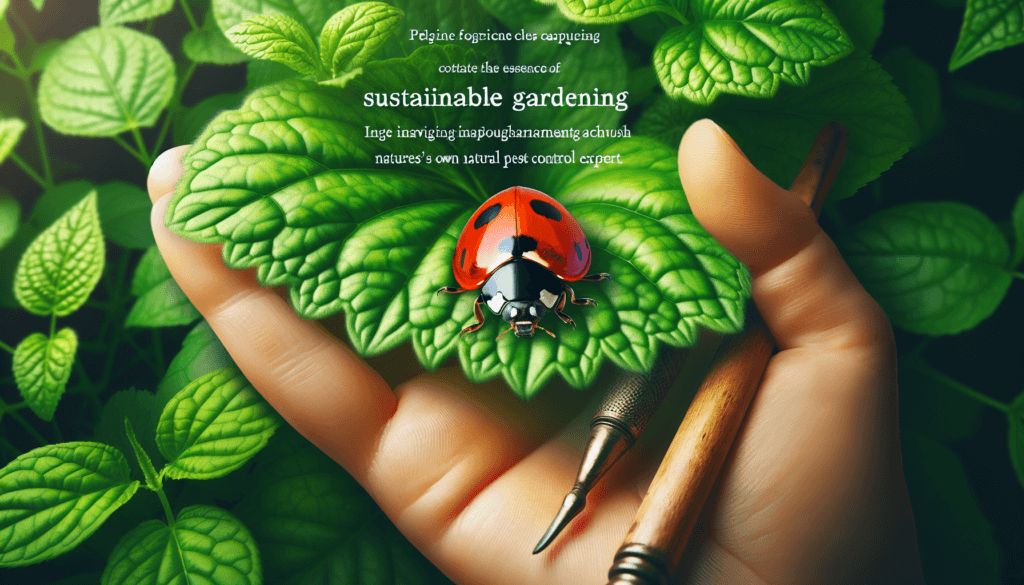Are pesky insects wreaking havoc on your beloved garden? If you’re looking for an eco-friendly and cost-effective solution, look no further! In this article, we will show you how to make your own natural pesticides for the garden. With simple ingredients that you may already have in your pantry, you can create effective and safe repellents to protect your plants from unwanted pests. Say goodbye to harmful chemicals and hello to a thriving, pest-free garden!

Choosing Natural Ingredients
When it comes to pest control in your garden, choosing natural ingredients can be a safer and more environmentally friendly option. Researching natural ingredients is an essential step in creating effective homemade pesticides. By understanding the properties and benefits of different ingredients, you can make informed choices that target specific pests and minimize the impact on beneficial insects and plants.
Researching natural ingredients
To begin, it’s important to research natural ingredients that have been proven effective in controlling pests. Look for ingredients that have insecticidal, fungicidal, or bactericidal properties. Common examples include garlic, onion, chili pepper, neem oil, wormwood, chrysanthemum, and mint. These ingredients not only repel pests but also have other beneficial properties, such as deterring wildlife and improving soil health.
Finding ingredients that target specific pests
Different pests require different approaches and ingredients to effectively control them. For example, garlic and onion sprays work well against soft-bodied insects like aphids and mites, while chili pepper sprays are effective against chewing insects like caterpillars and beetles. Neem oil, on the other hand, is a versatile ingredient that can combat a wide range of pests such as aphids, whiteflies, and spider mites. By identifying the specific pests in your garden, you can choose the ingredients that will be most effective in getting rid of them.
Considering safety and environmental impact
One of the key advantages of natural pesticides is their safety for both humans and the environment. When selecting ingredients, consider their toxicity levels and potential harm to beneficial insects, birds, and other animals. Aim for ingredients that have low toxicity and are harmless to non-target organisms. Additionally, make sure to choose organic ingredients to avoid introducing synthetic chemicals into your garden. By prioritizing safety and minimizing environmental impact, you can create a garden that thrives while keeping pests at bay.
Preparing the Ingredients
Before making homemade pest sprays, it’s important to properly prepare the ingredients to ensure their effectiveness. This involves harvesting fresh plants, drying or fermenting herbs, and extracting oils from citrus fruits.
Harvesting fresh plants
When using fresh plants like garlic, onion, wormwood, or chrysanthemum, it’s best to harvest them when they are at their peak. This is typically when the plants have fully developed but haven’t started to wither or decline. Harvesting fresh plants ensures that you capture their full potency and maximize their effectiveness in repelling pests. Simply cut the plants at the base, leaving enough stem for hanging and drying if necessary.
Drying or fermenting herbs
Many natural ingredients, such as wormwood, chrysanthemum, and mint, work best when dried or fermented. Drying herbs removes excess moisture, concentrates the active compounds, and increases their storage life. Hang the harvested herbs in a warm and well-ventilated area until they are completely dry. Fermentation, on the other hand, involves placing the herbs in a container with water or a natural liquid such as apple cider vinegar or yogurt. This process breaks down the herbs, releasing their beneficial compounds and increasing their potency.
Extracting oils from citrus fruits
Citrus fruits like oranges and lemons are rich in essential oils that have insecticidal properties. To extract these oils, start by peeling the fruits and removing any pith. Place the peels in a jar and cover them with a carrier oil, such as olive oil or almond oil. Allow the peels to steep in the oil for several weeks, shaking the jar occasionally. The oil will gradually absorb the fragrance and properties of the citrus peels, creating an effective natural pesticide.

Making Homemade Pest Sprays
Homemade pest sprays are a convenient and effective way to control pests in your garden. The following recipes use natural ingredients to create powerful sprays that can repel and deter a wide range of pests.
Garlic and onion spray
Garlic and onion sprays are effective against soft-bodied insects like aphids, mites, and whiteflies. To make the spray, crush several cloves of garlic or chop a medium-sized onion and add them to a spray bottle filled with water. Let the mixture steep for a few hours or overnight, then strain it into another spray bottle. Spray the solution on affected plants, making sure to cover both the tops and bottoms of the leaves. Reapply every few days or after rainfall for continued protection.
Chili pepper spray
Chili pepper sprays are effective against chewing insects like caterpillars and beetles. To make the spray, blend several chili peppers or a tablespoon of chili powder with water in a blender until smooth. Pour the mixture into a spray bottle and add a few drops of liquid dish soap to help the spray adhere to the plants. Shake well before use and spray it directly on the pests or on the affected plants. Be cautious when handling chili peppers, as they can cause skin and eye irritation.
Neem oil spray
Neem oil is a versatile and widely used natural pesticide that controls a variety of pests such as aphids, whiteflies, and spider mites. To create a neem oil spray, mix 1-2 tablespoons of neem oil with a few drops of liquid dish soap in a spray bottle filled with water. Shake the bottle well to emulsify the ingredients. Spray the solution on affected plants, covering all plant surfaces. Neem oil is most effective when applied in the early morning or evening to avoid direct sunlight, and it can be reapplied every 7-14 days as needed.
Creating Pest-Repelling Infusions
Infusions made from natural ingredients can be used to repel pests and protect your garden. By steeping herbs or flowers in water, you can create powerful infusions that deter pests while being safe for plants and beneficial organisms.
Wormwood infusion
Wormwood is a herb known for its powerful pest-repellent properties, particularly against insects like mosquitos. To make a wormwood infusion, place a handful of dried wormwood leaves or fresh leaves in a container filled with water. Let the mixture steep for a few days, stirring occasionally. Strain the infusion and pour it into a spray bottle or watering can. Apply the infusion to the areas of your garden where pests are a problem, making sure to spray or water the plants thoroughly.
Chrysanthemum infusion
Chrysanthemums contain a natural insecticide called pyrethrin, which is effective against a wide range of pests, including aphids, flies, and mosquitoes. To make a chrysanthemum infusion, gather a handful of dried chrysanthemum flowers or fresh flowers and place them in a container filled with water. Allow the flowers to steep for several hours or overnight. Strain the infusion and transfer it to a spray bottle. Spray the infusion on affected plants, focusing on infested areas. Repeat the application every few days for maximum pest control.
Mint infusion
Mint is not only a refreshing herb for culinary purposes but also a natural repellent for pests like ants, aphids, and rodents. To create a mint infusion, fill a container with water and add a handful of fresh mint leaves or dried leaves. Bruise the leaves slightly to release their fragrance and compounds. Allow the leaves to steep in the water for a few hours or overnight. Strain the infusion and transfer it to a spray bottle. Spray the mint infusion on affected areas, around plant bases, or near entry points for pests.

Using Pest-Attracting Traps
In addition to repellents, pest-attracting traps can be an effective tool in your natural pest control arsenal. By luring pests to a trap, you can reduce their populations and protect your plants without resorting to synthetic pesticides.
Apple cider vinegar trap
Apple cider vinegar traps are effective in capturing fruit flies and other flying insects. Fill a shallow container, such as a small dish or cup, with apple cider vinegar and add a few drops of dish soap to break the surface tension. The sweet scent of the vinegar attracts the pests, and the soap helps them sink into the liquid, preventing their escape. Place the traps near affected plants or areas of high pest activity. Check the traps regularly and empty them to maintain their effectiveness.
Dish soap fruit fly trap
Similar to apple cider vinegar traps, dish soap traps entice fruit flies and other flying insects. Fill a jar or bottle halfway with sweet fruit juice or a mixture of vinegar and water. Add a few drops of liquid dish soap to break the surface tension. Screw on the lid, then poke several small holes in it. The pests will be attracted to the scent and enter the container through the holes, but they won’t be able to escape due to the soapy water. Set up these traps near fruit trees, compost bins, or areas with ripe produce.
Beer slug trap
Slugs can be a nuisance in the garden, devouring tender leaves and causing damage to plants. An effective and environmentally friendly way to control slugs is by using beer traps. Bury a small container, such as a plastic cup or yogurt container, in the ground near the affected plants. Fill the container with beer and leave the rim at ground level. The slugs are attracted to the beer and will crawl into the container and drown. Empty and refill the traps regularly to maintain their efficacy.
Implementing Companion Planting
Companion planting involves strategically selecting plants that provide mutual benefits when grown together. By utilizing certain plant combinations, you can naturally deter pests and promote a healthy and harmonious ecosystem in your garden.
Marigolds to deter pests
Marigolds are known for their ability to deter various pests, including aphids, nematodes, and certain beetles. Their strong scent and pest-repelling compounds act as a natural deterrent, making them a popular choice for companion planting. Plant marigolds around vegetable crops or near plants that are prone to pest infestations. The bright blooms will not only add beauty to your garden but also help protect your plants from undesirable visitors.
Nasturtiums to repel aphids
Nasturtiums are a valuable addition to any garden as they serve multiple purposes. These vibrant, fast-growing plants not only add a splash of color but also act as a natural barrier against aphids. Aphids are attracted to nasturtiums, which leaves other plants in your garden relatively unharmed. By planting nasturtiums near susceptible plants or as a border around your garden, you can significantly reduce aphid populations and protect your valuable crops.
Lavender for general pest control
Lavender is not only recognized for its beautiful fragrance and soothing properties but also for its ability to repel a wide range of pests. Its scent acts as a natural deterrent to insects such as moths, fleas, and mosquitoes. Plant lavender near doors, windows, or seating areas to discourage insects from entering. Additionally, lavender can attract beneficial pollinators like bees and butterflies, making it an excellent companion plant for fruit and vegetable gardens.

Employing Natural Predators
In nature, there is a delicate balance between pests and their natural predators. By encouraging beneficial insects, attracting birds and bats, and using nematodes, you can create a harmonious ecosystem that keeps pest populations in check without resorting to harmful pesticides.
Encouraging beneficial insects
Beneficial insects, such as ladybugs, lacewings, and hoverflies, play a vital role in controlling pest populations. To attract these helpful garden allies, plant nectar-rich flowers like daisies, yarrow, and dandelions. Additionally, provide habitats such as insect hotels, birdbaths, and undisturbed areas with adequate shelter and food sources. By creating a welcoming environment for beneficial insects, you can reduce the need for chemical pesticides and promote a healthy ecosystem in your garden.
Attracting birds and bats
Birds and bats are natural predators of many garden pests, including insects, slugs, and even small rodents. To attract these beneficial creatures, provide food sources like bird feeders and nectar-rich flowers for birds, and bat houses or roosting boxes for bats. Planting trees and shrubs that offer shelter and nesting spots will also encourage their presence. Birds and bats will help keep pest populations in check, ensuring a thriving and pest-free garden.
Using nematodes
Nematodes are microscopic, beneficial roundworms that can help control soil-dwelling pests like grubs, beetles, and caterpillars. These nematodes seek out and enter the bodies of their prey, releasing bacteria that quickly kill the pests. Nematodes are available commercially and can be easily applied to the soil by mixing them with water and watering the affected areas. They are safe for humans, plants, and beneficial organisms, making them an effective and environmentally friendly solution for pest control.
Maintaining Garden Hygiene
Proper garden hygiene is essential for preventing and managing pest infestations. Regular cleaning and tidying, along with prompt removal of diseased plants, can help reduce pest populations and maintain a healthy growing environment.
Regularly cleaning and tidying
Keep your garden tidy by removing fallen leaves, plant debris, and weeds regularly. These materials can provide hiding places and breeding grounds for pests and diseases. Raking and cleaning up fallen fruit or vegetables will also discourage pests from congregating in your garden. Regularly inspect and clean plant containers, tools, and garden structures to prevent the buildup of pests and pathogens.
Removing diseased plants promptly
Diseased plants can be a magnet for pests and a potential source of infection for neighboring plants. Promptly remove any plants showing signs of disease, such as wilting, yellowing leaves, or unusual growths. Seal the infected plants in a plastic bag or trash bag and dispose of them properly, away from your garden. This will help prevent the spread of diseases and reduce the risk of attracting pests.
Improving soil health
Healthy soil is the foundation of a thriving garden and plays a crucial role in managing pests. To improve soil health, regularly add organic matter, such as compost or well-rotted manure, to enrich the soil and promote beneficial microbial activity. Healthy soil supports strong and robust plants, making them less susceptible to pests and diseases. By maintaining a balanced soil ecosystem, you can minimize the need for synthetic pesticides and create an environment where beneficial organisms can thrive.

Applying the Natural Pesticides
Now that you have your homemade natural pesticides ready, it’s important to use them properly for maximum effectiveness and safety.
Testing the spray on a small area
Before applying the pesticide to your entire garden or affected plants, it’s advisable to test it on a small area or a few leaves first. This will help ensure that the spray does not cause any adverse effects, such as burning or damaging the plants. If the test area shows no negative signs after 24-48 hours, you can proceed with confidence and apply the pesticide more broadly.
Applying evenly on affected plants
When spraying the pesticide, make sure to apply it evenly and thoroughly to all affected plant parts. Pay special attention to the undersides of leaves, where pests often hide and lay eggs. Use a fine mist sprayer or a pump sprayer to achieve good coverage. Be mindful of wind conditions to avoid drift and ensure that the spray reaches the intended targets.
Reapplying after rain or heavy watering
Natural pesticides, especially those made from water-based solutions, may need to be reapplied after rainfall or heavy watering. Rain can wash away the pesticide, reducing its effectiveness. Monitor your garden regularly and check the condition of your plants. If pests return or their activity persists after rain, it may be necessary to reapply the pesticide to maintain effective control.
Storing and Labeling Pesticides
Proper storage and labeling of homemade pesticides are essential for maintaining their effectiveness and ensuring safety.
Choosing appropriate containers
Select containers that are specifically designed for storing liquids and are made of materials such as glass or HDPE (high-density polyethylene) plastic. Avoid using containers that have previously held toxic substances or food products. Ensure that the containers have tight-fitting lids or caps to prevent leakage and evaporation.
Clearly labeling the contents
Label each container with the name of the pesticide, the date it was made, and any necessary precautions or instructions. Include a list of the ingredients used and their proportions. This will help you keep track of different formulations and ensure you use the pesticide appropriately. Additionally, if you have multiple pesticides, clearly distinguish between them to avoid confusion.
Storing in a cool and dark place
To maintain the potency and stability of your homemade pesticides, store them in a cool and dark place. Pesticides can be sensitive to light and heat, which can degrade their effectiveness over time. A cupboard or shelf in a dry and cool location, away from direct sunlight and extreme temperatures, is ideal for storing your homemade pesticides. Keep them out of reach of children and pets to prevent accidental exposure.
In conclusion, making your own natural pesticides for your garden is an empowering and eco-friendly way to protect your plants from pests. By choosing natural ingredients, preparing them properly, and employing different pest control methods, you can create a garden that thrives while minimizing the use of synthetic pesticides. Remember to test and apply the pesticides safely, practice good garden hygiene, and store them properly. With these tips, you can enjoy a beautiful and pest-free garden that is friendly to both you and the environment. Happy gardening!


